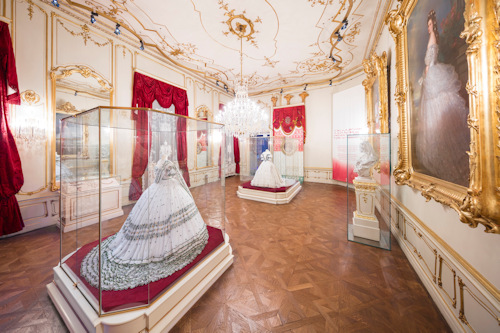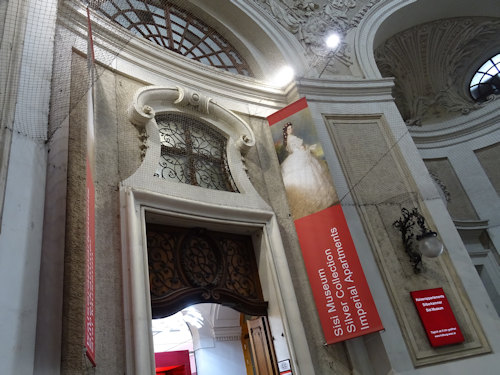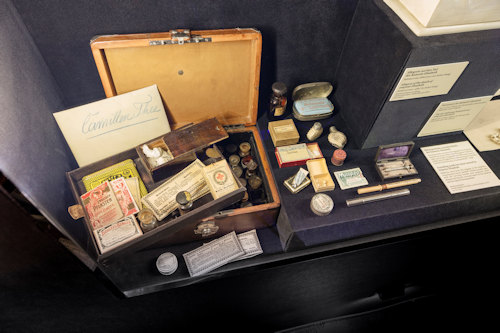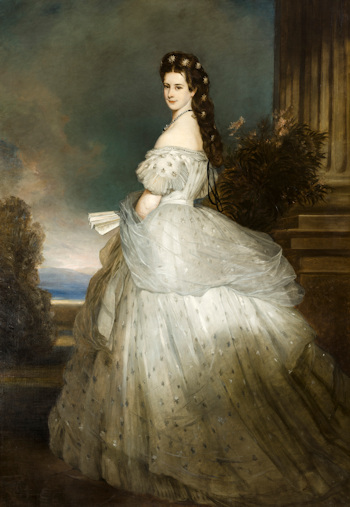
The first stop on the self-guided tour at the Hofburg takes you into the Sisi Museum, dedicated to the reality and myth of perhaps the most enigmatic of all Habsburg Empresses.
- Not a shrine, but a sensitive exploration of her life and character
- Full of historical exhibits, including…
- Original items from her possession
- Stunning replicas of dresses and jewellery
- Book a guided Sisi-themed tour* for your trip
- See also:
Who was Sisi?

(The museum includes faithful replicas of Elisabeth’s gowns and dresses; press photo © Schloß Schönbrunn Kultur- und Betriebsges.m.b.H., Severin Wurnig)
Sisi is the nickname of Empress Elisabeth (1837-1898), iconic wife of Emperor Franz Joseph, and the face that launched a thousand commemorative mugs, books, postcards, and films.
In short, a teenage Sisi married the young Austrian Emperor in a fairytale story that turned sour as the rigidity of court life overwhelmed her free spirit.
Elisabeth remains an enigma, a strange mix of romantic innocent and melancholic misanthrope. Vain yet withdrawn. Living life to the full, yet always unfulfilled. Unhappy and buffeted by the dark hand of fate, but hardly a tragic heroine.
I’d have liked to look into her eyes to see the true soul within.
(This is what happens when you spend too long in the Sisi museum. Or in Vienna, home of psychoanalysis.)
Inside the Sisi museum

(Entrance to the Sisi Museum and associated sights)
As the prime location on the self-guided tour of the Hofburg complex, the Sisi museum looks to give you some insight into Elisabeth’s life, loves and obsessions. In doing so, it’s not a shrine to the beautiful princess of myth. Nor is it a dry historical record.
In fact, the museum treads a middle path: Sisi fans and Sisi skeptics alike will find much to enjoy.
At the end I knew a lot more about the Empress, but still didn’t know who she was. Which I think is the point.
The museum proper begins with Sisi’s death mask and, for example, a wreath ribbon from her funeral. A very Viennese beginning. Then we learn of the legacy and legend of the empress.
This legend is illustrated with, for example, film clips, statues, newspaper excerpts and various commemorative memorabilia that documented (and created) the myth that grew up around the Empress, largely after her death.
The cult of Sisi made good propaganda for the monarchy, of course, and businesses saw an opportunity to commercialise her image (take a brief peek into the shop at the end of the tour for modern-day examples).
The museum then warns you that the truth about Sisi is a little different.
Subsequent displays trace the Empress’s life from her Bavarian childhood around the 1840s through to her assassination in Geneva in 1898, illustrating this biography with clothes, jewellery, letters, household items and more.
The journey reveals much of Sisi’s character and obsessions:
- The distaste for court etiquette and responsibility
- The love of riding (she was perhaps the best female rider in Europe)
- The dedication to her health, hair and looks
- The need to travel as a permanent search for distraction
- The melancholy and poetry
- Her high regard for the Hungarian people, etc.

(Take a peek inside Sisi’s medicine chest; press photo © Schloß Schönbrunn Kultur- und Betriebsges.m.b.H., Severin Wurnig)
Some highlights:
- A large model of the Hofburg area from the early 1900s, including those buildings planned but never built. You get a real feel for the scale and majesty of the complex
- Early mementos, such as childhood shoes, her paint box, a (rather decent) painting done by her when aged around ten, and an original wedding announcement
- The iconic portrait painting by Franz Xaver Winterhalter with the famous star jewels in Sisi’s hair
- Replicas of those diamond stars and the Hungarian coronation jewels
(I believe one of the original stars makes an appearance, too, containing 30 diamonds and a pearl.)

(Franz Xaver Winterhalter, Kaiserin Elisabeth, undated. Photo courtesy of and © Belvedere, Wien. Reproduced with permission under the terms of Creative Commons License CC BY-SA 4.0. Photo by Áment Gellért)
- A replica of the coronation robes she wore when crowned as Queen of Hungary in 1867 and her gown from the farewell ball in Munich held before she left for Vienna. Be sure to compare the elegance and delicacy of the two
- Her medicine chest (which contained cocaine, then valued for its clinical properties)
- A full reconstruction of the saloon car put at her disposal by the railways
…and much, much more.
All the information presented is in German and English, and the audio guide provides an important overview and chronology you might not get from the visual information alone; actors even recite quotes from Sisi and her poetry.
The end of the Sisi Museum then leads into the next stop on the Hofburg self-guided tour: the Kaiserappartements (Imperial apartments). There you learn more about Sisi’s character indirectly through the furnishings and décor of her actual living quarters.